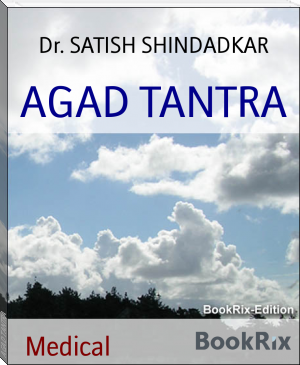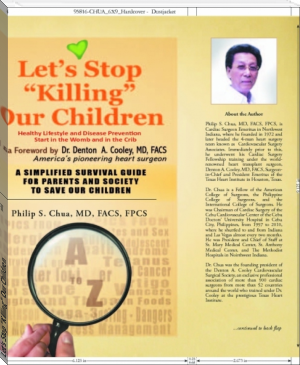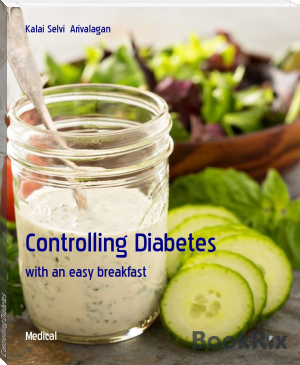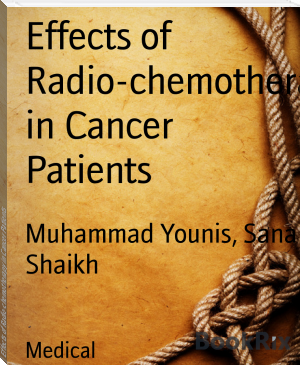AGAD TANTRA, Dr. SATISH SHINDADKAR [web based ebook reader .txt] 📗

- Author: Dr. SATISH SHINDADKAR
Book online «AGAD TANTRA, Dr. SATISH SHINDADKAR [web based ebook reader .txt] 📗». Author Dr. SATISH SHINDADKAR
सुश्रुत संहीता कल्पस्थान 8 मध्ये वृश्चिक उत्पत्ती (त्याच्या प्रकारानुसार) वर्णन केलेली आहे.
1) गोमय कोथाद्वारे उत्पन्न वृश्चिक हे मंद विष वृश्चिक.
2) काष्ठ व वीट इत्यादिंच्या कोथाद्वारे उत्पन्न वृश्चिक हे मध्य विष वृश्चिक
3) मृत सर्पाच्या कोथाद्वारे उत्पन्न वृश्चिक हे तीक्ष्णविष वृश्चिक आहे.
वृश्
चिक सामान्य विष लक्षणे :
चरक व वाग्भट यांच्या नुसार - वृश्चिक दंशानंतर सर्वप्रथम दंशस्थानी तीव्र दाह आणि नंतर शरिरात उर्ध्वभागी भेदवत दाह सर्वत्र पसरतो. पुन्हा दंशस्थानी या वेदना स्थिर होतात. दंशस्थान श्याववर्णी होते.
वृश्
चिक प्रकार, लक्षणे व चिकित्सा :
मंदविष मध्यविष तिक्ष्ण विष (सु.)
उग्रविष (च.)
महाविष (वा.)
12 प्रकार 3 प्रकार 15 प्रकार
दंशपश्चात वेदना-कंप, गात्रस्तंभ, कृष्णवर्णी रक्तस्त्राव, दंशस्थानी शोथ- दाह, स्वेद तीव्र मूर्च्छा, जिव्हाशोथ, भोजनावरोध सर्पदंशवत लक्षणे, दाह, ज्वर, रोमरंध्र व मुखाद्वारे कृष्णवर्णी रक्तस्त्राव
चुक्रतेल, विदारीगण सिद्ध तेल-यांचा सुखोष्ण परिषेक, घृताचा सुखोष्ण परिषेक मध्य व तीक्ष्ण वृश्चिक दंशामध्ये सर्पदंशवत चिकित्सा करावी. दंशस्थानी प्रच्छान करून रजनी, सैंधव, त्रिकटू, शिरीष फल व पुष्प यांचे चूर्णाने प्रतिसारण करावे.
असाध्य वृश्
चिकदंश लक्षणे :
हृदय, नासा व जिव्हा या स्थानी वृश्चिक दंश झाल्यास व‘णातून मांसधातूचे पतन होते. व अत्यंत तीव्र वेदना होऊन मृत्यू येतो.
Modern View - Scorpion
Anatomical consideration -
- Scorpion having crablike appearance with segmented tail.
- Tail ends in broad sac & prominent hollow sting connected to the venom secreting glands.
- The poisonous apparatus of the scorpion.
comprises of sting & associated venom gland.
- The dialated part of sting is called as ampula or vasicle.
It contains a pair of sac like venom glands which open individually by tear shaped apparatus one on each side.
- The sing is movably articulated to tail.
It is controlled by a pair of dorsal & a ventro lateral muscles.
The muscles orginate on the last segment of tail & work / functions antagonistically to each other.
General :
Scorpion are the terrestial anthropods. Found in tropical & subtropical region. 86 species found in India. of which Mesobuthus tamulus ( Indian red scorpion) & Palmaneus gravimanus ( black Scorpion) are the common ones.
Mesobuthus tamulus, is the most lethal species seen florished all over western maharashtra (Konkan)
Scorpion venom -
It contains polypeptides, free amino acids serotonin, hyluronidase, various enzymes acting like trypsinogen.
The polypeptide - is neurotoxic
Also, venom causes inhibition of calcium dependent potassium cannels.
The effect of venom in human is highly variable.
It depends upon :
- species & geographical location.
- the amount of venom injected.
- the age & sensitivity of victim.
- the site of the sting etc.
Clinical manifestations :
They can be divided into two groups.
Severe local pain at the site of sting radiating along with corresponding dermatomes without systemic involvement.
Mild (or absent) local pain but present with severe systemic involvement.
Local pain or benign sting :
Seen in sting by less poisonous scorpion species palmaneus gravimanus (black)
It is characterised by sudden onset of severe excruciating pain at the site of sting.
Local sweating, swelling & fasciculation’s are seen over the part of sting.
Subsequently pain radiates along the involved dermatomes.
Due to severe pain patients is anxious, mild sweating, or transient BP with bradycardia can be noted. but no signs of systemic involvement are seen.
Systemic Menifestations :
These are due to altered ion channed permiability.
Hence affecting ANS.
Parasympathtic stimulation :
Due to parasympathetic stimulation there is vomiting, profuse sweating all over body. Hypersalivation, mydriasis, bradicardia, hypotension, transient ventricular premature beats.
Sympathetic Stimulation :
Characterised by propped up eyes, puffy & anxious face, chest discomfort, perioral paraethesia. Tingling & numbness i.e. paraesthesia all over body, cool extremities, transient systolic murmur of mitral regurgitation. These changes persist for long duration than parasympathetic.
The clinically interesting finding observed is on arrival patient with systemic manifestations have tolerable mild/absent local pain.
but start getting severe intolerable pain as soon as there is improvement in peripheral circulation, warming of cool extremities.
i.e. accompanied with clinical improvement.
Hypertension -
Patient can have raised BP upto 210/160 mm of Hg with sinus bradycardia within 1-4 hrs of sting
Children & occasionally adults with sever hypertension tend to be confused agitated at times have generalized convulsions, transient hemiplegia.
Bilateral extensor planter response severe headaches
Propped up eyes & puffy face - in children suggestive of hypertension crisis.
Pulmonary Oedema -
Occurs 4-36 hrs after sting
Clinically it can be suspected when respiratory rate > 24/min., intractable cough, low volume fast thready pulse, summation gallops, systolic murmurs, basal moist rales.
Causes of death -
Lethal ventricular arrhythmias occur within 15-30 min of sting
Pulmonary oedema.
Investigations -
TLC
Cardiac enzymes - CPK mb
Serum amylase
Serum potassium
Serum calcium
Chest X - Ray
ECG.
Management :
No sting should be taken unless observed for 24 hrs irrespective of species of scorpion involved.
Local pain -
Cut at sting & torniquet
Ice packs over sting
For severe excruciating pain local anasthetia without andrenalin
Wash the wound with water, borax or KMnO4
Repeated injections of local anesthesia are often required for pain relief.
Oral diazepam & NSAIDS with first initial dose of xylocaine can be given to prolong pain relief.
Correction of dehydration :
Dehydration due to vomiting, excessive salivation & profuse sweating should be corrected by continuous oral rehydration solution.
This helps to correct initial hypotension & shock.
IV or hydration by nasal tube may be necessary in Children.
Scorpion antivenin: Though specific antidote.
Can’t reverse or prevent cardiovascular morbidity & mortality.
Not free from anaphylaxis
Prazocin :-
Selective adrenergic receptor blocker.
As alpha receptors play vital role in the pathogenesis of cardiac failure & pulmonary edema due to scorpion sting, hence Prazocin is hlepful.
It’s pharmacological properties can antagonise the haemodynamic hormonal & metabolic effects of Scorpion venaom.
It can be administered by oral route.
It is free from anaphylaxis
Dose - Children - 125 - 250 micro grams.
Adult - 500 micro grams. 3 hourly
Till clinical improvement i.e. upto appearance of pain & other menifestation.
Pulmonary oedema :
Life threatening time limiting emergency needs rapid intervention.
Propped up position.
IV aminophyline 5 mg/kg.
If available - isosorbide buccal spray powder of nitroglycerine rubbed on gums.
Frusemide 10-20 mg - reduce the preload & pulmonary congestion.
IV sodium nitroprusside drip
3-5 micro gm / Kg/min can be started for massive pulmonary oedema & raised under caution.
Cardiac arrhythmias -
Mexiletine is drug of choice
IV amidoarone can be used with caution.
Atropine, steroids, antihistamines, b blocker, Ca channel blockers, excessive diaretics, adrenalive & narcotics should be avoided.
अलर्क विषबाधा
वर्गीकरण : जंगम विष - दंष्ट्राविष- Animal Poison-Neurotic Poison
अलर्क विषग्रस्त प्राण्याची लक्षणे :
कफप्रधान वातादि दोष प्राण्यांच्या संज्ञावह स्त्रोतसाचा आश्रय घेऊन संज्ञानाश करतात आणि धातूंमध्ये अत्याधिक क्षोभ उत्पन्न करतात त्यामुळे लालास्त्राव, अंधत्व, बाधीर्य, निष्प्रयोजन इतस्तत: सगळीकडे पळणे,पुच्छ-हनु-स्कंध-शिर शिथिल होणे व शिरोरूजा, निर्माण होते आणि असा प्राणी दिसेल त्याला दंश करतो.
अलर्क विषग्रस्त मनुष्याची लक्षणे :
दंशस्थानी कण्डू, तोदवत वेदना, वैवर्ण्य, संज्ञानाश, क्लेद, भ्रम, दाह, आरक्तता, शोथ, ग्रंथी इत्यादी लक्षणे उत्पन्न होतात.
वृद्ध वाग्भटांनी जो रूग्ण श्वानवत् चेष्टा करतो तसेच जलाचे दर्शन, स्पर्शन अथवा शब्दाने देखील त्रस्त होतो तो असाध्य समजावा असे म्हटले आहे. यालाच ‘जलसंत्रास’ असे संबोधले आहे.
चिकित्सा :
दंशस्थानी छेद देऊन पीडनाने रक्तनिर्हरण करून त्यास्थानी घृताने दग्ध करावे.
दंशस्थानी अगदलेपन करावे.
पुराण घृत पानार्थ द्यावे.
तीव्र रेचक स्वरूपात अर्कक्षीर द्यावे.
Rabies [Hydrophobia]
Defination : Rabies, is an acute highly fatal viral disease of the central nervous system caused by lyssavirus type I.
It is primarily a zoonotic disease of warm blooded animals, particularly carnivorous such as dogs, cats, wolves etc.
It is transmitted to man usually by bites or licks of rabid animals.
Classical hydrophobia is clinically characterized by a long and variable incubation period.
A short period of illness due to encephalomyelitis ending in death, despite intensive care.
* Mode of transmission -
Animals bites - generally dog bite
Licks - through mucosa and abraded skin
A aerosols -
Person to person - by infected saliva / bite.
Incubation period : Highly variable 4 days to several years.
The incubation period depends upon
Site of bite
Severity of bite
Number of wounds
Amount of virus injected
Species of biting animal
Protection provided by clothing and treatment taken if any.
Pathogenesis :
Rabies virus replicates in muscles or connective tissue cells at or near the site of introduction.
Then it attaches to nerve endings and enters peripheral nerves.
It spreads from the site of infection centripetally via peripheral nerves towards the CNS.
It ascends passively through the nerve associated tissue space.
Following infection of the CNS, the virus spreads centrifugally in peripheral nerves to many tissues, including skeletal and myocardial muscle, adrenal glands and skin.
The salivary gland invasion is crucial for transmission of the virus to another animal or human.
Rabies in Man
Clinical Picture :
Rabies in man is called hydrophobia.
The disease begins with prodromal symptoms such headache, malaise, sore throat and slight fever lasting for 3-4 days.
Sometimes pain and tingling at the site of bite.
Prodromal stage is followed by widespread excitation and stimulation of all parts of nervous system usually in order - sensory system, Motor system, Sympathetic system and mental system.
Sensory system - The patients is intolerant to noise, bright light or a cold draught of air.
Motor system - Examination of motor system may show increased reflexes and muscle spasm.
Sympathetic system - In this system, dilatation of pupils, increased perspiration, salivation, lacrimation etc. are seen.
Mental changes - They include fear of death, anger, irritability, depression. The systems are progressively aggravated and all attempts of swallowing liquid become unsuccessful.
At later stage, the more sight or sound of water may provoke spasm of muscles of deglutition.
This characteristic symptom of hydrophobia is pathognomonic of rabies and is absent in other animals.
The patient may die abruptly during one of the convulsions or may pass on to the stage of paralysis or coma.
* Management of dog bite :
1. Local treatment of wound :
As soon as we know the dog has bitten a person,
the first step is to wash the wound with soap and water,
this will help in reducing number of virus available.
Cleansing : It should be done in running water plenty of soap for at least 5 min.
Chemical treatment : The wound is then cleaned by povidone iodine, ethyl alcohol etc.
Saturing : It is done if the wound is big.
Antirabies Serum : For prevention of rabies local application of antirabies serum or its infiltration around wound has been highly effective.
2) General Treatment :
Inj. TT 0.5 ml im. should be given.
Use of Antibiotics for prevention of opportunistic bacterial infection.
Observe the animal for 10 days. It is important for further guideline of treatment.
Immunization
Vaccination with either ARV, PCEC, HCDC, PVCV should be done.
* Treatment of Rabies :
There is no specific treatment.
The case management include following procedure.
The patient should be isolated in a quiet room for protection from external stimuli such as noise, bright light or cold air. As the external stimuli may precipitate spasm or convulsions.
Relieve anxiety and pain by liberal use of sedatives Morphine in dose 30-40 mg. may be given repeatedly.
If spastic muscular contractions are present use drug with curare like muscle relaxant action.
Ensure hydration and diuresis.
Intensive therapy in form of respiratory and cardiac support may be given.
Patients with rabies are potentially infectious because the virus may be present in the saliva vomits, tears, urine and other body fluids.
Hence, the person attending the patient should take complete precautions and use gloves, face masks, goggles etc.
Vaccines :
- Antirabies Vaccine - S.C. 14 injection.
1. Human Difloid cell vaccine.
2. PCEC - Purified chick embryo cell vaccive.
1 ml. im in deltoid muscles.
0, 1, 3, 7, 14, 30, 90 - (doses on days from bite)
***
मूषक
विष वर्गीकरण : जंगम विष
विषाधिष्ठान - शुक्र, प्रकार - 18(आयुर्वेदानुसार)
लक्षणे :
मूषकाच्या दंत, नख आदि ज्या अंगाला शुक्र लागलेले असते, त्या अंगांचे मनुष्याच्या ज्या अंगास स्पर्श होतो, त्या ठिकाणी रक्त दुष्टी होऊन पिताभता येते, त्यामुळे अनेक स्थानिक व सार्वदेहिक लक्षणे उत्पन्न होतात.
स्थानिक - ग्रंथी, शोथ, कोठ, मण्डलकुष्ठ इ.
सार्वदेहिक - भ्रम, अरूची, शीतज्वर, शूल, अंगशैथिल्य, कंप, पर्वभेद, रोमहर्ष, मूर्च्छा, दीर्घकाल व्रण, दुर्बलता, श्वास, छर्दी इ.
मूषकदंश कृच्छ्रसाध्य असतो आणि जर मूर्च्छा, सर्वांगशोथ, वैवर्ण्य, क्लेद, कर्णबाधीर्य, ज्वर, शिरोगौरव इत्यादी लक्षणे दिसल्यास असाध्य समजावे.
आधुनिक मतानुसार, मूषकात उपस्थित असणार्या Bacteria मुळे – Rat bite fever होऊ शकतो.
चिकित्सा :
स्थानिक : दंशस्थानी त्वरित दहनकर्म करावे. त्यानंतर शिरीषादि विषघ्नद्रव्यांचा लेप करावा.
शोधन चिकित्सा : तीव‘ वमन योगांद्वारे शरीरशोधन करावे. गरजेनुसार विरेचन, शिरोविरेचन, अंजन इ. करावे.
शमन चिकित्सा : विविध अगदांचा प्रयोग करावा आणि लाक्षणिक चिकित्सा करावी.
आधुनिक दृष्टया : Antibiotics, analgesics, Injection TT इ. चा वापर करावा.
***
शतपदी
विषाधिष्ठान - दंष्ट्रा, प्रकार- 8 (सुश्रुत)
लक्षणे :
दंशस्थानी शोथ, शूल, लालीमा, पीटिका, उत्पन्न होतात. तसेच, हृद्दाह, स्वेद, भ्रम इ. लक्षणे उत्पन्न होतात.
चिकित्सा :
दंशस्थानी मधुर द्रव्य (शर्करा, गुड) शतपदीच्या मुखाजवळ टाकल्यास दंश सोडते. त्यानंतर दंशस्थानी हरिद्रा, दारूहरिद्रा, सैंधव व घृत यांचा लेप करावा. तसेच, हरिद्रा, दारूहरिद्रा, गैरीक, मन:शिल यांचा लेप करावा.
आधुनिक मतानुसार, शतपदीच्या





Comments (0)